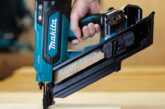
In the latest instalment of our Tech Talk series, Martin Dunn, senior training officer at Makita, helps you get to grips with the manufacturer’s Super Joint System.
Excess tool vibration and motor burnout are problems that tradespeople are more than familiar with, and a frustration that seemingly just ‘comes with the territory’. Fortunately, technologies such as our Super Joint System (SJS and SJS II) are enabling those on-site to move past these concerns to improve the efficiency, safety and durability of angle grinders, reducing stoppages and enabling work to progress at a faster rate.
Understanding our Super Joint System
Recognising the need to provide increased power, lengthen machine life and improve user handling, Makita designed its innovative Super Joint System technology to deliver optimum power and torque performance. These technologies are suitable on Makita’s mains powered angle grinders with wheel diameters from 115mm to 230mm, as well as die grinders, wall chasers and concrete planers. The technology works to reduce machine vibration, elongating the life cycle of tools and reducing the need to constantly replace machines. This enables work to progress at a faster rate and also means that tradespeople can reduce on-site vibration levels, which is an increasingly important health and safety concern.
The first generation
Makita introduced the Super Joint System to offer increased benefits to the operator. It provides greater durability by protecting the motor and gears from shock at start up, or if the grinder grabs the material whilst in use. The system functions as a mechanical clutch system that features a coil spring wrapped around the internal drive spindle. The coil tightens around the spindle when the machine is started, to deliver the motor’s power smoothly and efficiently to the drive shaft or spindle. Should the blade catch or jam in the material being cut, the coil spring relaxes to instantly disengage the gears from the motor, in order to avert any overload. In turn, this minimises wear and tear on the machine and greatly reduces the risk of gearbox damage, as well as protecting the operator.
Evolving the system
SJS II technology provides increased durability by absorbing the vibration produced by the wheel during cutting or grinding material. Without SJS II, the vibration from the grinding wheel is transmitted through the spindle, gears and motor into the body of the machine and then into the user’s hands and arms. Grinders with SJS II technology feature a cam and leaf spring added to the spindle, that is designed to absorb the movement of the disc and prevent the transmission of vibration. As a result, vibration in machines fitted with the SJS II system is significantly reduced, even when compared with the original SJS products.
Feeling the benefits
SJS and SJS II technology makes work safer, more comfortable and more efficient. Reduced vibration levels mean tradespeople can work for longer periods more comfortably, whilst also decreasing the risk of reaching vibration exposure limit value (ELV), at which point all work must stop. Not only does this protect tradespeople from costly project delays, but also elongates the life cycle of tools, therefore reducing maintenance and replacement costs.
![]()







